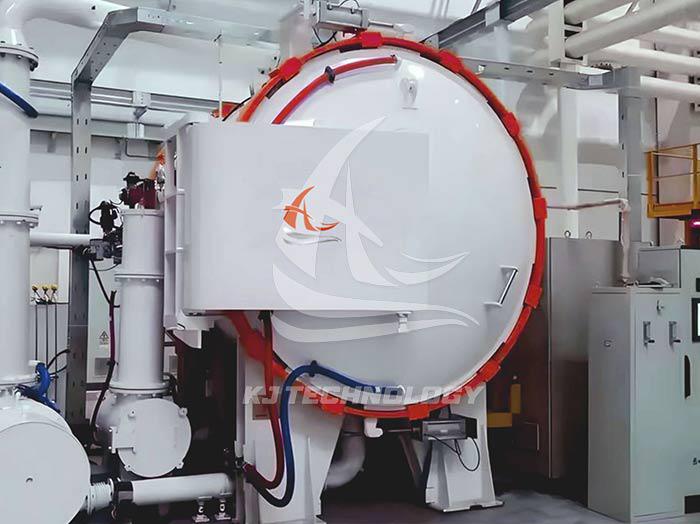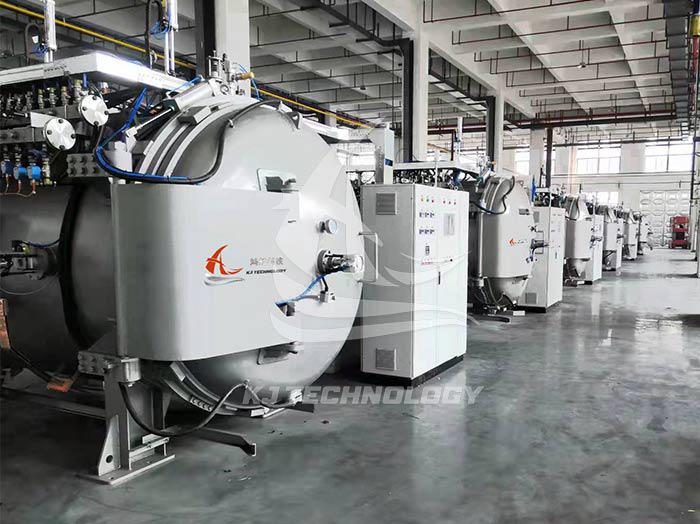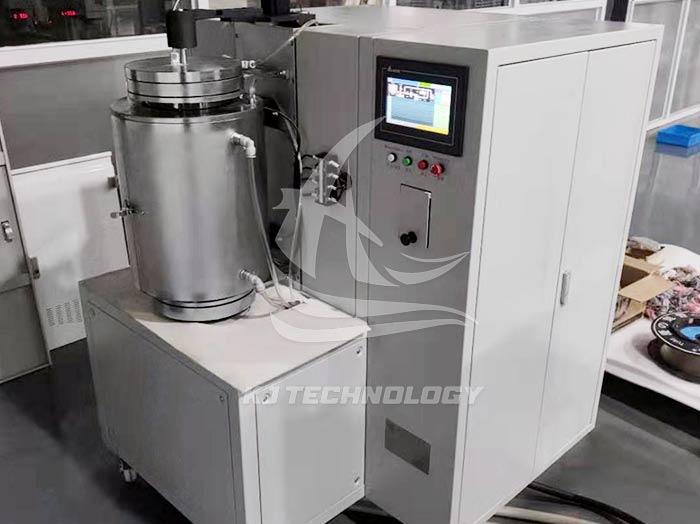Temperature selection of gas quenching furnace
 10-27-2025 Author: KJ technology
10-27-2025 Author: KJ technology
The temperature selection of gas quenching furnace should comprehensively consider factors such as material type, process requirements, workpiece size and shape. The following are specific suggestions:
1. Select temperature based on material type
Carbon steel and low-alloy steel
Hypoeutectoid carbon steel: The quenching heating temperature is usually 30-50 ℃ above Ac3 (austenitizing temperature), for example, the quenching temperature of 45 steel is about 840-860 ℃.
Eutectoid and hypereutectoid carbon steel: The quenching heating temperature is 30-50 ℃ above Ac1 (the transition temperature from pearlite to austenite), for example, the quenching temperature of T10 steel is about 770-800 ℃.
Low alloy steel: The quenching temperature is similar to carbon steel, but needs to be adjusted according to the alloy element content. For example, the quenching temperature of 40Cr steel is about 840-860 ℃.
alloy steel
Medium high alloy steel: The quenching temperature is usually 30-50 ℃ above Ac1 or Ac3, for example, the quenching temperature of 5CrNiMo steel is about 830-850 ℃.
High speed steel: The quenching temperature needs to be relatively high, for example, the quenching temperature of W18Cr4V steel is 1260-1280 ℃, and it needs to be preheated in stages (800-850 ℃) to reduce thermal stress.
Stainless steel and heat-resistant steel
Chromium nickel austenitic stainless steel: The quenching temperature is usually 1050-1100 ℃, and high-purity argon gas protection is required to prevent oxidation and decarburization.
Heat resistant steel: The quenching temperature is adjusted according to the composition, for example, the quenching temperature of GH4037 high-temperature alloy is about 1150~1180 ℃.
2. Select temperature according to process requirements
Reduce deformation
Low temperature quenching: For workpieces with complex shapes and easy deformation, a lower limit than the conventional quenching temperature (such as Ac3+10-20 ℃) can be used, and a slow cooling medium (such as oil quenching) can be used.
Graded quenching: isothermal residence near the Ms point (the temperature at which martensite begins to transform) to reduce thermal stress, for example, the graded quenching temperature of 9Mn2V steel is 150-170 ℃.
increase hardness
High temperature quenching: By appropriately increasing the quenching temperature (such as Ac3+50~70 ℃) while ensuring that it does not burn, the degree of austenitization can be increased and the hardness after quenching can be improved. For example, the quenching temperature of Cr12MoV steel can reach 1020-1050 ℃.
Control grain size
Avoid overheating: During high-temperature quenching, it is necessary to prevent grain coarsening. For example, quenching high-speed steel at a temperature exceeding 1280 ℃ can cause grain coarsening and reduce toughness.
Grain refinement: By multiple preheating processes (such as 500-600 ℃, 800-850 ℃) and rapid cooling, the grain can be refined and the overall performance can be improved.
3. Select temperature based on workpiece size and shape
Large sized workpieces
Low temperature slow heating: Large workpieces need to be preheated in stages (such as 500~600 ℃, 800~850 ℃), and the heating rate should be reduced (30~70 ℃/h) to reduce thermal stress.
Uniform heating: The vacuum furnace using convection heating device can shorten the heating time in the low-temperature section and improve temperature uniformity (within ± 5 ℃).
Thin walled or precision parts
High pressure gas quenching: Thin walled parts (such as 0.5-2mm) can be rapidly cooled with high-pressure nitrogen gas (1-2MPa) to reduce deformation.
Low temperature quenching: Precision parts (such as molds) can be quenched at a temperature slightly lower than the lower limit of conventional quenching temperature (such as Ac3+10-20 ℃), and combined with oil quenching or gas quenching.
4. Example of Temperature Selection
Automotive Gear (20CrMnTi)
Quenching temperature: 880 ℃ (oil quenching), combined with preheating at 500-600 ℃, can reduce deformation and improve tooth surface hardness.
High speed steel cutting tool (W18Cr4V)
Quenching temperature: 1260-1280 ℃, preheating in stages (500-600 ℃, 800-850 ℃), combined with high-pressure nitrogen quenching, can achieve high hardness and good toughness.
Stainless steel valve (304)
Quenching temperature: 1050-1100 ℃, protected by high-purity argon gas, can prevent oxidation and decarburization, and improve surface smoothness.








